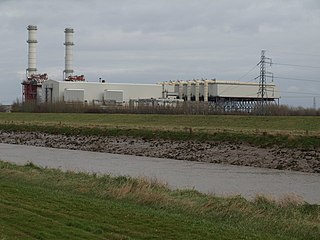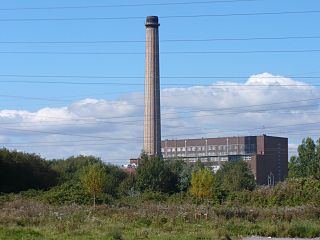This is a list of electricity-generating power stations in Wales , sorted by type and name, with installed capacity (May 2007).
Note that the DBERR maintains a comprehensive list of operational UK power stations here:
| Name | Location | Coordinates | Output | Notes |
|---|---|---|---|---|
| Trawsfynydd | Gwynedd | 52°55′29.51″N3°56′54.38″W / 52.9248639°N 3.9484389°W | 470 MW | (Decommissioned in 1991) |
| Wylfa | Anglesey | 53°25′00″N4°29′00″W / 53.41667°N 4.48333°W | 980 MW | (Decommissioned in 2015) |
Coal-fired power stations:
| Name | Location | Coordinates | Output | Notes |
|---|---|---|---|---|
| Aberthaw power stations | Vale of Glamorgan | 51°23′14″N3°24′18″W / 51.38722°N 3.40500°W | 1500 MW | (Decommissioned in 2020) |
| Uskmouth A power station | Near Newport | 51°32′57″N2°58′14″W / 51.54917°N 2.97056°W | 228 MW | (Decommissioned in 1981) |
| Uskmouth B power station | Near Newport | 51°32′57″N2°58′14″W / 51.54917°N 2.97056°W | 393 MW | Initially burning coal with intermittent biomass firing up until 2017, planned conversion to burn biomass and waste abandoned. [1] Current operational status unclear. |
| Cardiff power stations | Cardiff | 51°29'42"N 03°08'45"W | 87.6 MW | Commissioned 1894 operational until late 1960s |
| Carmarthen Bay Power Station | Burry Port | 51°40′47″N 04°14′35″W | 360 MW | (Decommissioned in 1984) |
| Llanelly power station [2] | Llanelli | 51°41'33"N 04°10'15"W | 24 MW | operating until 1967 |
| Marchwiel power station | Wrexham | 53°01'55"N 02°55'25"W | 12.41 MW | operating until 1959 |
| Newport power stations | Newport | 51°35'11"N 02°59'08"W | 80 MW | operating 1895 to late 1970s |
| Rogerstone power station | Rogerstone near Newport | 126 MW | (Decommissioned in 1984) | |
| Llynfi Power Station [2] | Bridgend | 51°34′13″N 03°36′40″W | 120 MW | (Decommissioned in 1977) |
| Tir John power station | Swansea | 51°37′35″N 03°53′50″W | 142 MW | Oil-fired from 1967 (Decommissioned in 1976) |
| Upper Boat power station | Pontypridd | 51°34'34"N 3°18'07"W | 144 MW | (Decommissioned in 1972) |
| Penarth power station | 2.2 MW | Operating 1948/9, closed by 1958/9 [3] | ||
| Bridgend power station | 2.0 MW | Operating 1948/9, closed by 1958/9 [3] | ||
| Pontypridd power station | 1.8 MW | Operating 1948/9, closed by 1958/9 [3] | ||
| Penydarren power station | 0.52 MW | Operating 1948/9, closed by 1958/9 [3] | ||
Gas (or combined gas/coal) fired power stations:
| Name | Location | Coordinates | Output | Notes |
|---|---|---|---|---|
| Baglan Bay power station | Neath Port Talbot | 51°37′11″N3°49′47″W / 51.61972°N 3.82972°W | 582 MW [4] | Closed in 2020 |
| Barry Power Station | Vale of Glamorgan | 51°24′29″N3°13′43″W / 51.40806°N 3.22861°W | 245 MW | Decommissioned March 2019 [5] |
| Connah's Quay Power Station | Flintshire | 53°13′56″N3°04′53″W / 53.23222°N 3.08139°W | 1380 MW | Originally coal-fired PF, 6x Parsons 30 MW turbines. Commissioned 1955. [2] |
| Deeside Power Station | Flintshire | 53°14′02″N3°02′02″W / 53.23389°N 3.03389°W | 500 MW | |
| Pembroke Power Station | Pembroke | 51°40′59″N4°59′18″W / 51.68306°N 4.98833°W | 2000 MW | (Planning approved 2009), operational 2012 |
| Severn Power Station | Uskmouth | 51°32′52″N2°58′35″W / 51.54778°N 2.97639°W | 824 MW | Mothballed August 2020 [6] |
| Shotton Power Station | Flintshire | 53°14′02″N3°01′58″W / 53.23389°N 3.03278°W | 210 MW | CHP (decommissioned 2012) [7] |
| BioGen Gwyriad | Gwynedd | 53°02′52″N2°59′35″W / 53.047741°N 2.993057°W | 3.5 MW | Biogas [8] |
Hydro-electric power stations:
| Name | Location | Coordinates | Output | Notes |
|---|---|---|---|---|
| Cwm Dyli hydro power station [2] | Gwynedd | 10 MW | commissioned 1906 operational | |
| Dinorwig Power Station | Gwynedd | 53°7′7″N4°6′50″W / 53.11861°N 4.11389°W | 1728 MW | (pumped storage) |
| Dolgarrog power station | Conwy (county borough) | 53°11'28"N 3°50'33"W | 28 MW | commissioned 1907 operational 2020 |
| Dolgelley power station | Dolgellau | 148 kW | hydro + oil engine | |
| Ffestiniog Power Station | Gwynedd | 52°58′51″N3°58′8″W / 52.98083°N 3.96889°W | 360 MW | (pumped storage) |
| Machynlleth A power station | Powys | 250 kW | hydro + oil engine [2] | |
| Maentwrog power station [2] | Gwynedd | 52°56'10"N 4°00'15"W | 30 MW | commissioned 1928, refitted 1988-92 |
| Rheidol Power Station | Ceredigion | 52°23′46″N3°54′00″W / 52.39611°N 3.90000°W | 49 MW | |
| River Tawe Barrage | Swansea | 51°36′58″N3°55′44″W / 51.61611°N 3.92889°W | ||
| Towyn power station [2] | Tywyn | 950 kW | hydro + oil engine | |
| Radyr Hydro Scheme | Cardiff | 51°31'9.79"N 3°15'13.50"W | 394 kW | Hydro (River Weir Screw Turbines) |
Oil-fired power stations:
| Name | Location | Coordinates | Output | Notes |
|---|---|---|---|---|
| Aberystwyth power station | Ceredigion | 52°24'45"N 4°05'03"W | 5 MW | Diesel fired generators, closed by 1978 |
| Haverfordwest power station [2] | Pembrokeshire | 8.465 MW | Oil engines (8) operational 1959 | |
| Machynlleth A and B power stations | Powys | 522 kW (A), 4.258 MW (B) | Diesel fired generators, closed by 1978 | |
| Milford Haven power station | Pembrokeshire | 815 kW | Oil engines, closed 28 February 1958 | |
| Pembroke Power Station | Pembrokeshire | 51°40′59″N4°59′18″W / 51.68306°N 4.98833°W | 2000 MW | closed 1999, now demolished |
| Lampeter power station | 400 kW | Internal combustion (diesel), Operating 1948/9, closed by 1958/9 [3] | ||
| Llandrindod Wells power station | 231 kW | Internal combustion (diesel), Operating 1948/9, closed by 1958/9 [3] | ||
| St Clears power station | 113 kW | Internal combustion (diesel), Operating 1948/9, closed by 1958/9 [3] | ||
| Aberayron power station | 100 kW | Internal combustion (diesel), Operating 1948/9, closed by 1958/9 [3] | ||
Wind power generating facilities:
| Name | Location | Coordinates | Output | Notes |
|---|---|---|---|---|
| Alltwalis Wind Farm | Carmarthenshire | 51°58′24″N4°15′3″W / 51.97333°N 4.25083°W | 23 MW | |
| Brechfa Forest Wind Farm | Gwernogle, Carmarthenshire | 90 MW | ||
| Carno wind farm | Carno, Powys, Mid Wales | 52°33′1″N3°36′1″W / 52.55028°N 3.60028°W | 49 MW | |
| Cefn Croes wind farm | Ceredigion | 52°24′18″N3°45′03″W / 52.40500°N 3.75083°W | 58.5 MW | |
| Moel Maelogen | Conwy | 53°08′07″N3°43′25″W / 53.13528°N 3.72361°W | 14.3 MW | |
| North Hoyle Offshore Wind Farm | Liverpool Bay | 53°26′N3°24′W / 53.433°N 3.400°W | 60 MW | |
| Pen y Cymoedd | Neath | 51°41′01″N03°41′01″W / 51.68361°N 3.68361°W | 228 MW | |
| Rhyd-y-Groes | Anglesey | 7 MW | ||
| Rhyl Flats | Liverpool Bay | 53°22′N03°39′W / 53.367°N 3.650°W | 90 MW | |
| Gwynt y Môr | Irish Sea | 53°27′N03°35′W / 53.450°N 3.583°W | 576 MW | (consent granted 2008, construction began 2011) |

Sutton Bridge Power Station is an 819 MW gas-fired power station in Sutton Bridge in the south-east of Lincolnshire in South Holland, England. It is situated on Centenary Way close to the River Nene. It is a major landmark on the Lincolnshire and Norfolk border and on clear days with its bright red lights it can be easily seen as far away as Hunstanton.

The Uskmouth power stations refers to a series of two coal-fired power stations at the mouth of the River Usk in the south-east of Newport, Wales. The first of the two station, Uskmouth A power station, was built in the 1940s and demolished in 2002.